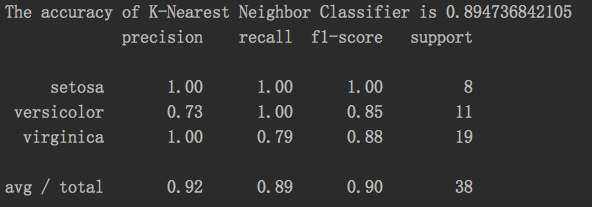chapter02 K近邻分类器对Iris数据进行分类预测
寻找与待分类的样本在特征空间中距离最近的K个已知样本作为参考,来帮助进行分类决策。
与其他模型最大的不同在于:该模型没有参数训练过程。无参模型,高计算复杂度和内存消耗。
#coding=utf8 # 从sklearn.datasets 导入 iris数据加载器。 from sklearn.datasets import load_iris # 从sklearn.model_selection中导入train_test_split用于数据分割。 from sklearn.model_selection import train_test_split # 从sklearn.preprocessing里选择导入数据标准化模块。 from sklearn.preprocessing import StandardScaler # 从sklearn.neighbors里选择导入KNeighborsClassifier,即K近邻分类器。 from sklearn.neighbors import KNeighborsClassifier # 依然使用sklearn.metrics里面的classification_report模块对预测结果做更加详细的分析。 from sklearn.metrics import classification_report iris = load_iris() # 从使用train_test_split,利用随机种子random_state采样25%的数据作为测试集。 X_train, X_test, y_train, y_test = train_test_split(iris.data, iris.target, test_size=0.25, random_state=33) # 对训练和测试的特征数据进行标准化。 ss = StandardScaler() X_train = ss.fit_transform(X_train) X_test = ss.transform(X_test) # 使用K近邻分类器对测试数据进行类别预测,预测结果储存在变量y_predict中。 knc = KNeighborsClassifier() knc.fit(X_train, y_train) y_predict = knc.predict(X_test) # 使用模型自带的评估函数进行准确性测评。 print 'The accuracy of K-Nearest Neighbor Classifier is', knc.score(X_test, y_test) print classification_report(y_test, y_predict, target_names=iris.target_names)
结果:







【推荐】国内首个AI IDE,深度理解中文开发场景,立即下载体验Trae
【推荐】编程新体验,更懂你的AI,立即体验豆包MarsCode编程助手
【推荐】抖音旗下AI助手豆包,你的智能百科全书,全免费不限次数
【推荐】轻量又高性能的 SSH 工具 IShell:AI 加持,快人一步
· 从 HTTP 原因短语缺失研究 HTTP/2 和 HTTP/3 的设计差异
· AI与.NET技术实操系列:向量存储与相似性搜索在 .NET 中的实现
· 基于Microsoft.Extensions.AI核心库实现RAG应用
· Linux系列:如何用heaptrack跟踪.NET程序的非托管内存泄露
· 开发者必知的日志记录最佳实践
· winform 绘制太阳,地球,月球 运作规律
· AI与.NET技术实操系列(五):向量存储与相似性搜索在 .NET 中的实现
· 超详细:普通电脑也行Windows部署deepseek R1训练数据并当服务器共享给他人
· 【硬核科普】Trae如何「偷看」你的代码?零基础破解AI编程运行原理
· 上周热点回顾(3.3-3.9)